Thermal Properties and Dynamic Rheological Characterization of Dioscorea Starch Gels
Abstract
1. Introduction
2. Results and Discussion
2.1. Chemical Composition of Yam Starches
2.2. Rheological Properties
2.3. Thermal Properties of Dioscorea Starches
3. Conclusions
4. Materials and Methods
4.1. Materials
4.2. Methods
4.2.1. Yam Starch Extraction
4.2.2. Proximate Composition of Starch Samples
4.2.3. Amylose Content
4.2.4. Thermal Properties
4.2.5. Preparation of Starch Gels
4.2.6. Rheological Characterization of Starch Gels
4.2.7. Statistical Analysis
Author Contributions
Funding
Institutional Review Board Statement
Informed Consent Statement
Data Availability Statement
Acknowledgments
Conflicts of Interest
References
- Ehounou, A.E.; Cornet, D.; Desfontaines, L.; Marie-Magdelein, C.; Maledon, E.; Nudol, E.; Beurier, G.; Rouan, L.; Brat, P.; Lechaudel, M.; et al. Predicting quality, texture and chemical content of yam (Dioscorea alata L.) tubers using near infrared spectroscopy. J. Near Infra. Spectro. 2021, 29, 128–139. [Google Scholar] [CrossRef]
- FAOSTAT Statistical Database. Food and Agriculture Organization of the United Nations. 2019. Available online: http://www.fao.org/faostat/en/ (accessed on 3 March 2022).
- Ai, Y.; Jane, J. Gelatinization and rheological properties of starch. Starch/Stärke 2015, 67, 213–224. [Google Scholar] [CrossRef]
- Otegbayo, B.O.; Ogunniyan, D.; Akinwumi, B. Physicochemical and functional characterization of yam starch for potential industrial applications. Starch/Stärke 2014, 66, 235–250. [Google Scholar] [CrossRef]
- Ai, Y.; Jane, J. Understanding Starch Structure and Functionality. In Starch in Food; Woodhead Publishing: Sawston, UK, 2018; pp. 151–178. [Google Scholar] [CrossRef]
- Bourne, M. Food Texture and Viscosity: Concept and Measurement; Elsevier: Amsterdam, The Netherlands, 2002. [Google Scholar]
- Koocheki, A.; Razavi, S.M. Effect of Concentration and Temperature on Flow Properties of Alyssum homolocarpum Seed Gum Solutions: Assessment of Time Dependency and Thixotropy. Food Biophys. 2009, 4, 353–364. [Google Scholar] [CrossRef]
- Karwasra, B.L.; Gill, B.S.; Kaur, M. Rheological and structural properties of starches from different Indian wheat cultivars and their relationships. Int. J. Food Prop. 2017, 20 (Suppl. S1), S1093–S1106. [Google Scholar] [CrossRef]
- Gunasekaran, S.M.; Mehmet, A.K. Dynamic oscillatory shear testing of foods- selected applications. Trends Food Sci. Technol. 2000, 11, 115–127. [Google Scholar] [CrossRef]
- Chen, L.; Ma, R.; Zhang, Z.; Huang, M.; Cai, C.; Zhang, R.; McClements, D.J.; Tian, Y.; Jin, Z. Comprehensive investigation and comparison of surface microstructure of fractionated potato starches. Food Hydrocoll. 2019, 89, 11–19. [Google Scholar] [CrossRef]
- Singh, J.; Singh, N.; Saxena, S.K. Effect of fatty acids on the rheological properties of corn and potato starch. J. Food Eng. 2002, 52, 9–16. [Google Scholar] [CrossRef]
- Tanimola, A.R.; Otegbayo, B.O.; Akinoso, R. Physicochemical properties of yam starches from fifty-five lines of Dioscorea species. Food Res. 2022, 6, 49–61. [Google Scholar] [CrossRef]
- Otegbayo, B.O.; Tran, T.; Ricci, J.; Gibert, O. In situ dynamic rheological analysis of raw yam tubers: A potential phenotyping tool for quality evaluation. J. Sci. Food Agric. 2023. Early view. [Google Scholar] [CrossRef]
- Otegbayo, B.O. Rheological and Physicochemical Characterization of Yam Starch for Potential Industrial Application. Technical Report of Post Doctoral Research Submitted to IITA Funded by AWARD/AGROPOLIS FONDATION. In Proceedings of the Triennial Symposium of the International Society for Tropical Root Crops (ISTRC), Montpelier, France, 23–28 September 2012; pp. 1–77. [Google Scholar]
- Castanha, N.; Villar, J.; da Matta, M.D., Jr.; Dos Anjos, C.B.P.; Augusto, P.E.D. Structure and properties of starches from Arracacha (Arracacia xanthorrhiza) roots. Int. J. Biol. Macromol. 2018, 117, 1029–1038. [Google Scholar] [CrossRef]
- Londoño-Restrepo, S.M.; Rincón-Londoño, N.; Contreras-Padilla, M.; Millan-Malo, B.M.; Rodriguez-Garcia, M.E. Morphological, structural, thermal, compositional, vibrational, and pasting characterization of white, yellow and purple Arracacha Lego-like starches and flours (Arracacia xanthorrhiza). Int. J. Biol. Macromol. 2018, 113, 1188–1197. [Google Scholar] [CrossRef] [PubMed]
- Yong, H.; Wang, X.; Sun, J.; Fang, Y.; Liu, J.; Jin, C. Comparison of the structural characterization and physicochemical properties of starches from seven purple sweet potato varieties cultivated in China. Int. J. Biol. Macromol. 2018, 120, 1632–1638. [Google Scholar] [CrossRef] [PubMed]
- Zhu, F. Isolation, Composition, Structure, Properties, Modifications, and Uses of Yam Starch. Compr. Rev. Food Sci. Food Saf. 2015, 14, 357–386. [Google Scholar] [CrossRef]
- Dhital, S.; Shrestha, A.K.; Gidley, M.J. Relationship between granule size and in vitro digestibility of maize and potato starches. Carbohydr. Polym. 2010, 82, 480–488. [Google Scholar] [CrossRef]
- Naidoo, K.; Amonsou, E.O.; Oyeyinka, S.A. In vitro digestibility and some physicochemical properties of starch from wild and cultivated amadumbe corms. Carbohydr. Polym. 2015, 125, 9–15. [Google Scholar] [CrossRef] [PubMed]
- Pérez, S.; Bertoft, E. The molecular structures of starch components and their contribution to the architecture of starch granules: A comprehensive review. Starch-Stärke 2010, 62, 389–420. [Google Scholar] [CrossRef]
- Chang, Y.H.; Lim, S.T.; Yoo, B. Dynamic rheology of corn starch– sugar composites. J. Food Eng. 2014, 64, 521–527. [Google Scholar] [CrossRef]
- Moorthy, S.N.; Larsson, H.; Eliasson, A.C. Rheological characteristics of different tropical root starches. Starch/Stärke 2000, 60, 233–247. [Google Scholar] [CrossRef]
- Redy, I.; Seib, P.A. Modified waxy wheat starch compared to modified waxy corn starch. J. Cereal Sci. 2000, 31, 25–39. [Google Scholar] [CrossRef]
- Pycia, K.; Gałkowska, D.; Juszczak, L.; Fortuna, T.; Witczak, T. Physicochemical, thermal and rheological properties of starches isolated from malting barley varieties. J. Food Sci. Technol. 2015, 52, 4797–4807. [Google Scholar] [CrossRef]
- Sundaram, H.; Voigts, B.O.B.; Beer, K.; Meland, M. Comparison of the rheological properties of viscosity and elasticity in two categories of soft tissue fillers: Calcium hydroxylapatite and hyaluronic acid. Dermatol. Surg. 2010, 36, 1859–1865. [Google Scholar] [CrossRef] [PubMed]
- Barua, S.; Hanewald, A.; Bächle, M.; Mezger, M.; Srivastav, P.P.; Vilgis, T.A. Insights into the structural, thermal, crystalline and rheological behaviour of various hydrothermally modified elephant foot yam (Amorphophallus paeoniifolius) starch. Food Hydrocoll. 2022, 129, 107672. [Google Scholar] [CrossRef]
- Tabilo-Munizaga, G.; Barbosa-Cánovas, G.V. Rheology for the food industry. J. Food Eng. 2005, 67, 147–156. [Google Scholar] [CrossRef]
- Singh, J.; Kaur, L.; McCarthy, O.J.; Moughan, P.J.; Singh, H. Rheological and textural characteristics of raw and par-cooked taewa (Maori potatoes) of New Zealand. J. Texture Stud. 2008, 39, 210–230. [Google Scholar] [CrossRef]
- Ross-Murphy, S.B.; Shatwell, K.P. Polysaccharide strong and weak gels. Biorheology 1993, 30, 217–227. [Google Scholar] [CrossRef]
- Keetels, C.J.A.M.; Van Vliet, T.; Walstra, P. Gelation and retrogradation of concentrated starch systems. Food Hydrocoll. 1996, 10, 355–362. [Google Scholar] [CrossRef]
- Chakraborty, I.; Govindaraju, I.; Kunnel, S.; Managuli, V.; Mazumder, N. Effect of Storage Time and Temperature on Digestibility, Thermal, and Rheological Properties of Retrograded Rice. Gels 2023, 9, 142. [Google Scholar] [CrossRef]
- Ferry, J.D. Viscoelastic Properties of Polymers, 4th ed.; John Wiley & Sons Inc.: New York, NY, USA, 1980; pp. 1–33. [Google Scholar]
- Lu, T.J.; Duh, C.S.; Lin, J.H.; Chang, Y.H. Effect of granular characteristics on the viscoelastic properties of composites of amylose and waxy starches. Food Hydrocoll. 2008, 22, 164–173. [Google Scholar] [CrossRef]
- Lii, C.Y.; Tsai, M.L.; Tseng, K.H. Effect of amylase content on the rheological properties of rice starch. Cereal Chem. 1996, 73, 415–420. [Google Scholar]
- Tarahi, M.; Shahidi, F.; Hedayati, S. Physicochemical, Pasting, and Thermal Properties of Native Corn Starch–Mung Bean Protein Isolate Composites. Gels 2022, 8, 693. [Google Scholar] [CrossRef]
- Amani, N.G.; Buleon, A.; Kamenan, A.; Colonna, P. Variability in starch and physico-chemical and functional properties of yam (Dioscorea spp.) cultivated in Ivory Coast. J. Sci. Food Agric. 2004, 84, 2085–2096. [Google Scholar] [CrossRef]
- Pérez, E.; Gibert, O.; Rolland-Sabaté, A.; Jiménez, Y.; Sánchez, T.; Giraldo, A.; Pontoire, B.; Guilois, S.; Lahon, M.C.; Reynes, M.; et al. Physicochemical, functional, and macromolecular properties of waxy yam starches discovered from “Mapuey” (Dioscorea trifida) genotypes in the Venezuelan Amazon. J. Agric. Food Chem. 2011, 59, 263–273. [Google Scholar] [CrossRef] [PubMed]
- Jiang, Q.; Gao, W.; Shi, Y.; Li, X.; Wang, H.; Huang, L.; Xiao, P. Physicochemical properties and in vitro digestion of starches from different Dioscorea plants. Food Hydrocoll. 2013, 32, 432–439. [Google Scholar] [CrossRef]
- Zou, J.; Li, Y.; Su, X.; Wang, F.; Li, Q.; Xia, H. Structure and Processing Properties of Nine Yam (Dioscorea opposita Thunb) Starches from South China: A Comparison Study. Molecules 2022, 27, 2254. [Google Scholar] [CrossRef]
- Chang, Y.H.; Lin, J.H.; Chang, S.Y. Physicochemical properties of waxy and normal corn starches treated in different anhydrous alcohols with hydrochloric acid. Food Hydrocolloid 2006, 20, 332–339. [Google Scholar] [CrossRef]
- Ali, N.A.; Dash, K.K.; Routray, W. Physicochemical characterization of modified lotus seed starch obtained through acid and heat moisture treatment. Food Chem. 2020, 319, 126513. [Google Scholar] [CrossRef]
- Stevenson, D.G.; Domoto, P.A.; Jane, J.L. Structures and functional properties of apple (Malus domestica Borkh) fruit starch. Carbohydr. Polym. 2006, 63, 432–441. [Google Scholar] [CrossRef]
- Martinez Villadiego, K.; Arias Tapia, M.J.; Useche, J.; Ledesma, Y.; Leyton, A. Thermal and morphological characterization of native and plasticized starches of sweet potato (Ipomoea batatas) and diamante yam (Dioscorea rotundata). J. Polym. Environ. 2020, 29, 871–880. [Google Scholar] [CrossRef]
- Chen, N.; Wang, Q.; Wang, M.X.; Li, N.Y.; Briones, A.V.; Cassani, L.; Prieto, M.A.; Carandang, M.B.; Liu, C.; Gu, C.M.; et al. Characterization of the physicochemical, thermal and rheological properties of cashew kernel starch. Food Chem. X 2022, 15, 100432. [Google Scholar] [CrossRef]
- Jayakody, L.; Hoover, R.; Liu, Q.; Donner, E. Studies on tuber starches. II. Molecular structure, composition and physicochemical properties of yam (Dioscorea sp.) starches grown in Sri Lanka. Carbohydr. Polym. 2007, 69, 148–163. [Google Scholar] [CrossRef]
- Sandhu, K.S.; Siroha, A.K. Relationships between physicochemical, thermal, rheological and in vitro digestibility properties of starches from pearl millet cultivars. LWT Food Sci. Technol. 2017, 83, 213–224. [Google Scholar] [CrossRef]
- Liu, X.X.; Liu, H.M.; Fan, L.Y.; Qin, G.Y.; Wang, X.D. Effect of various drying pretreatments on the structural and functional properties of starch isolated from Chinese yam (Dioscorea opposita Thumb.). Int. J. Biol. Macromol. 2019, 11, 1299–1309. [Google Scholar] [CrossRef]
- Miao, W.B.; Ma, S.Y.; Peng, X.G.; Qin, Z.; Liu, H.M.; Cai, X.S.; Wang, X.D. Effects of various roasting temperatures on the structural and functional properties of starches isolated from tigernut tuber. LWT 2021, 151, 112149. [Google Scholar] [CrossRef]
- Otegbayo, B.O.; Bokanga, M.; Asiedu, R. Physico-chemical composition of yam starch: Effect on textural quality of yam food product (Pounded yam). J. Food Agric. Environ. 2011, 9, 145–150. [Google Scholar]
- AOAC. Official Methods of Analysis of the Association of Analytical Chemists, 21st ed.; Association of Analytical Chemists: Gathersburg, MD, USA, 2019. [Google Scholar]
- Mestres, C.; Matencio, F.; Pons, B.; Yajid, M.; Fliedel, G. A rapid method for the determination of amylose content by using differential scanning calorimetry. Starch/Stärke 1996, 48, 2–6. [Google Scholar] [CrossRef]
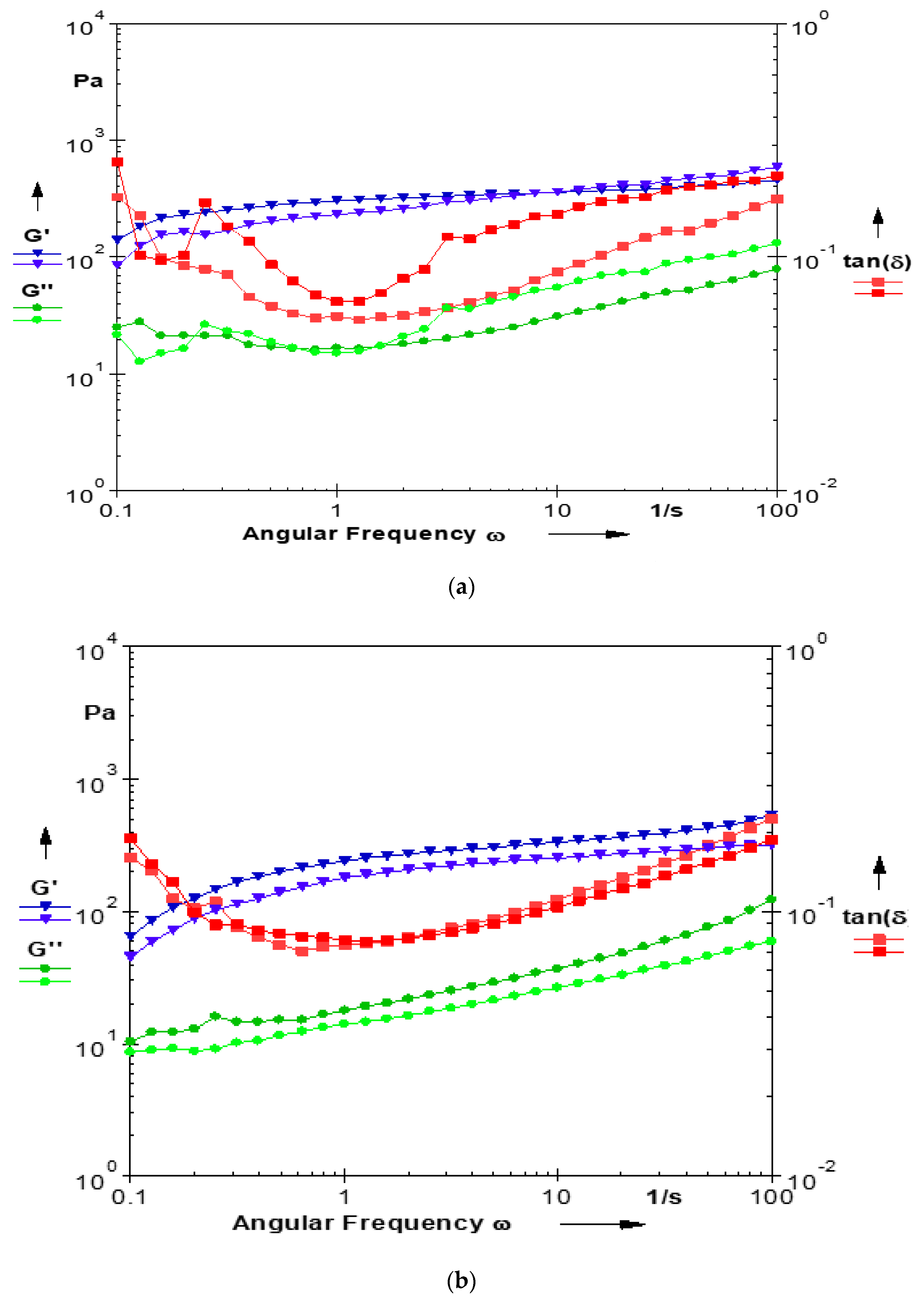

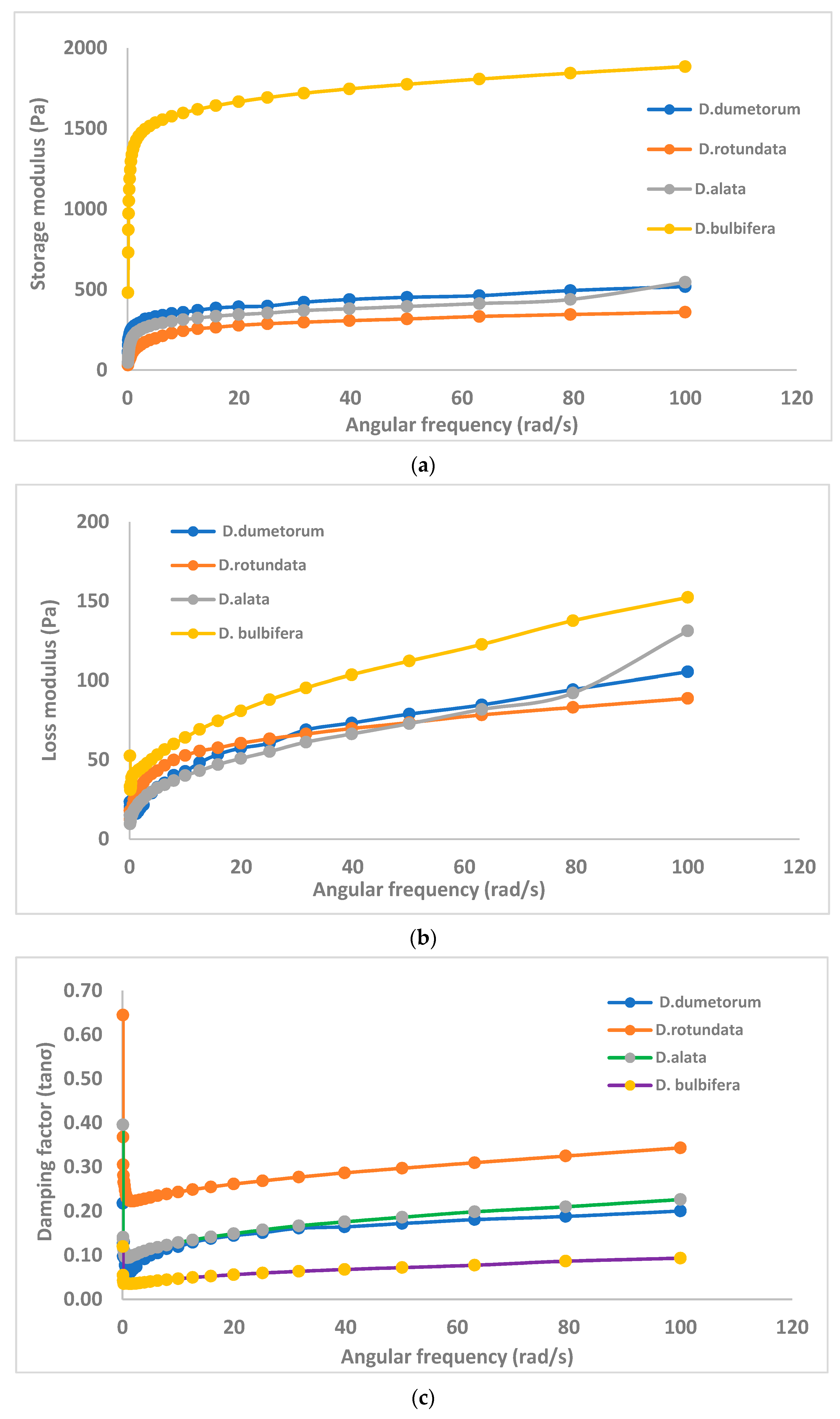
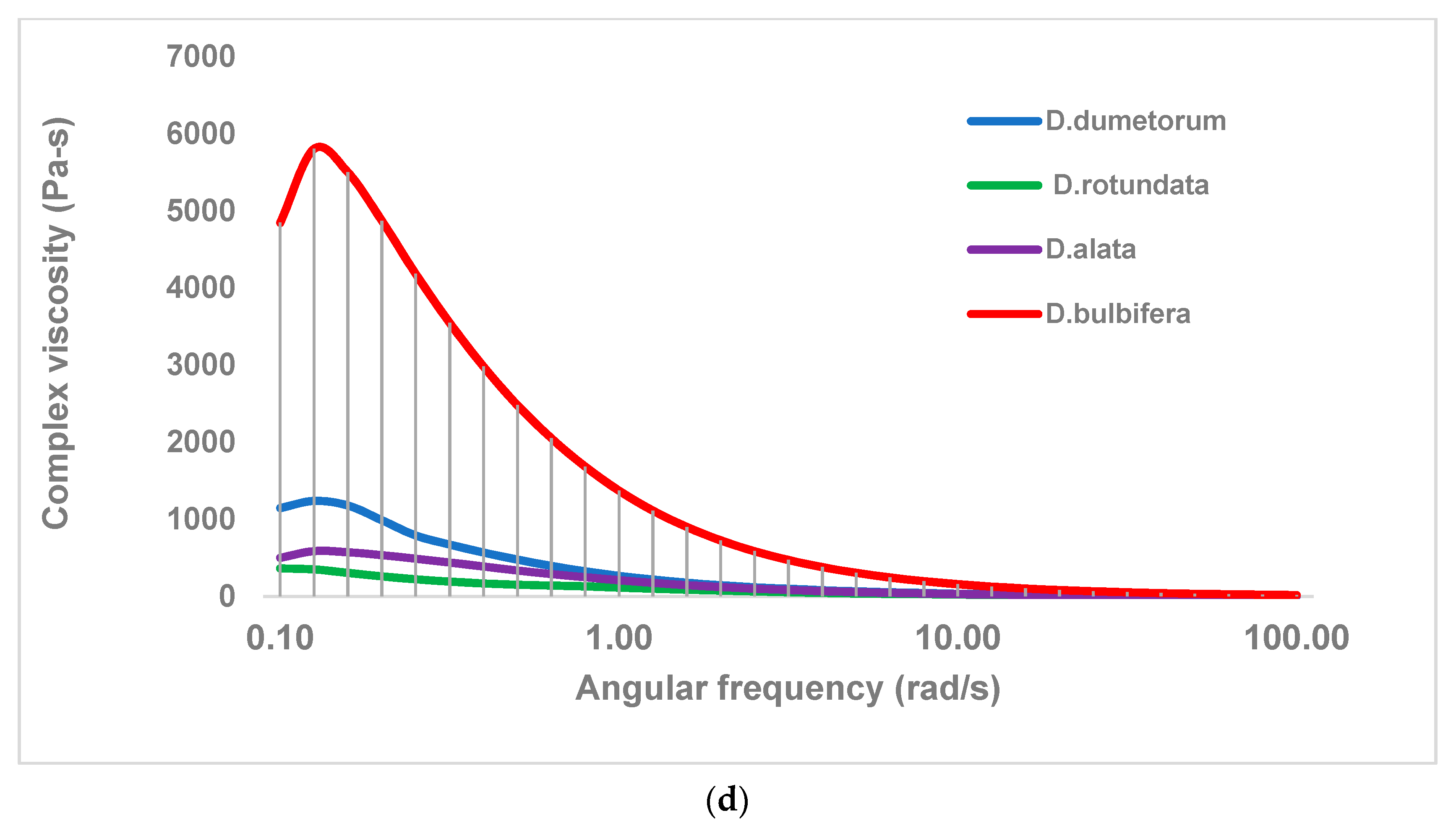

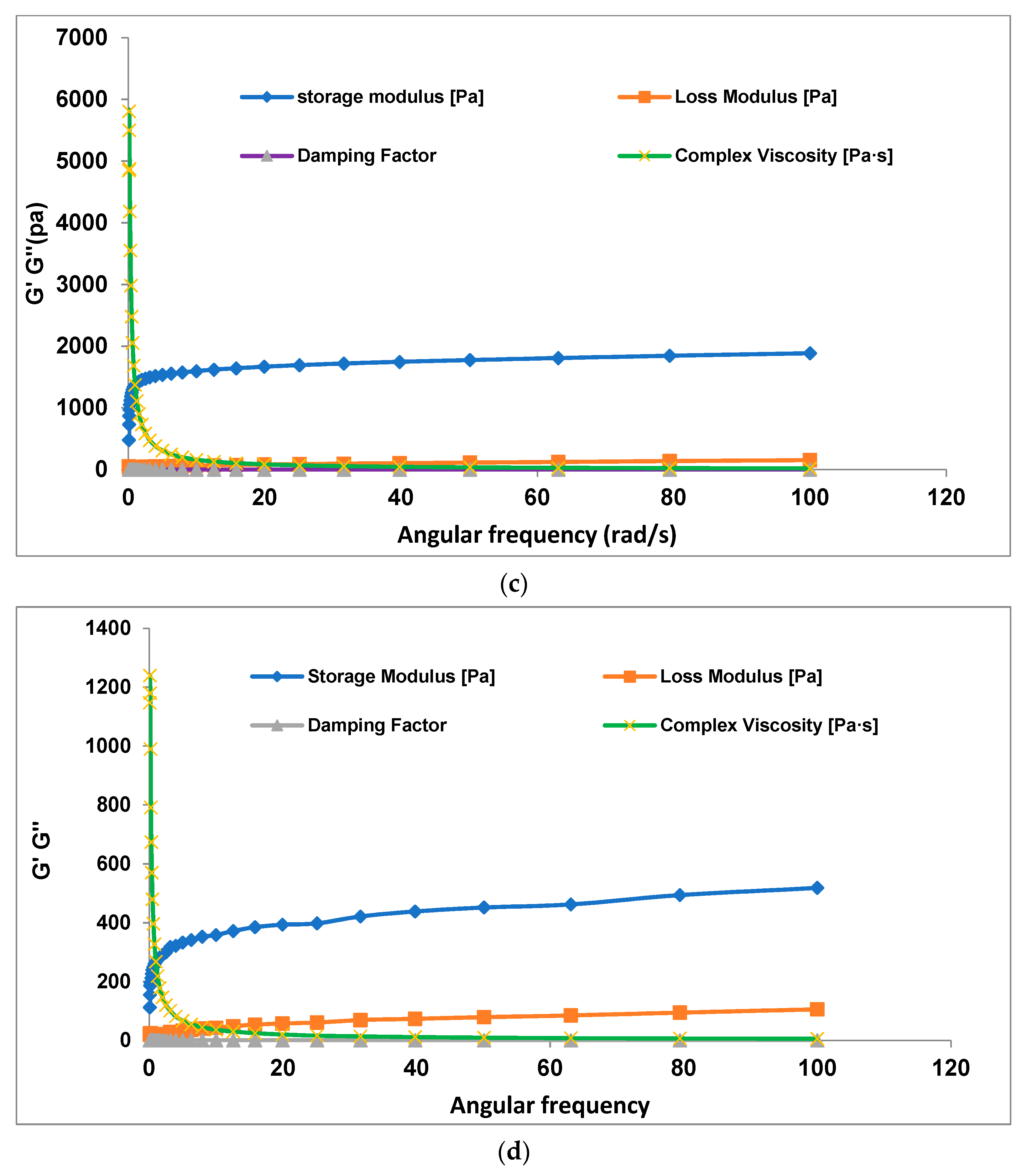
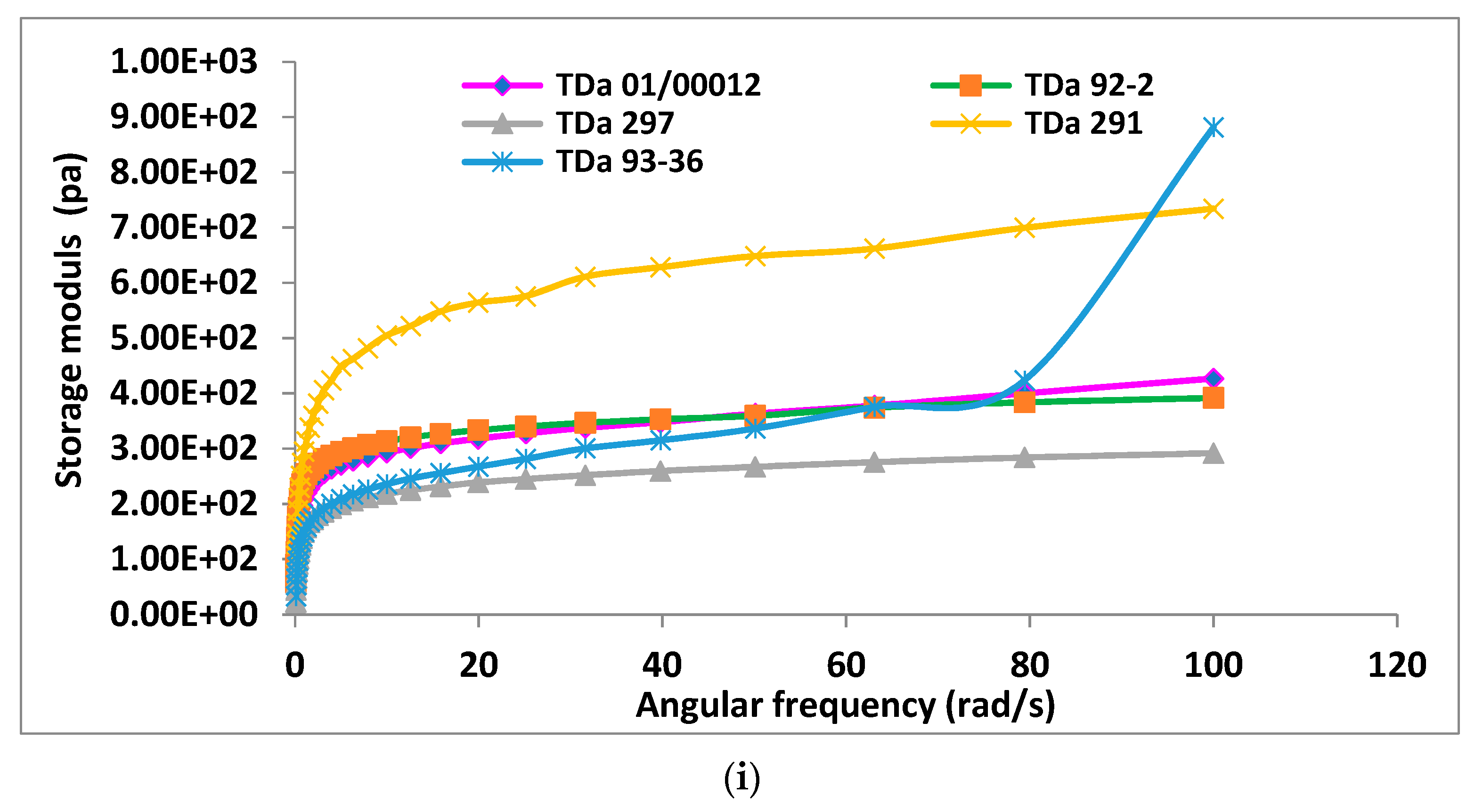


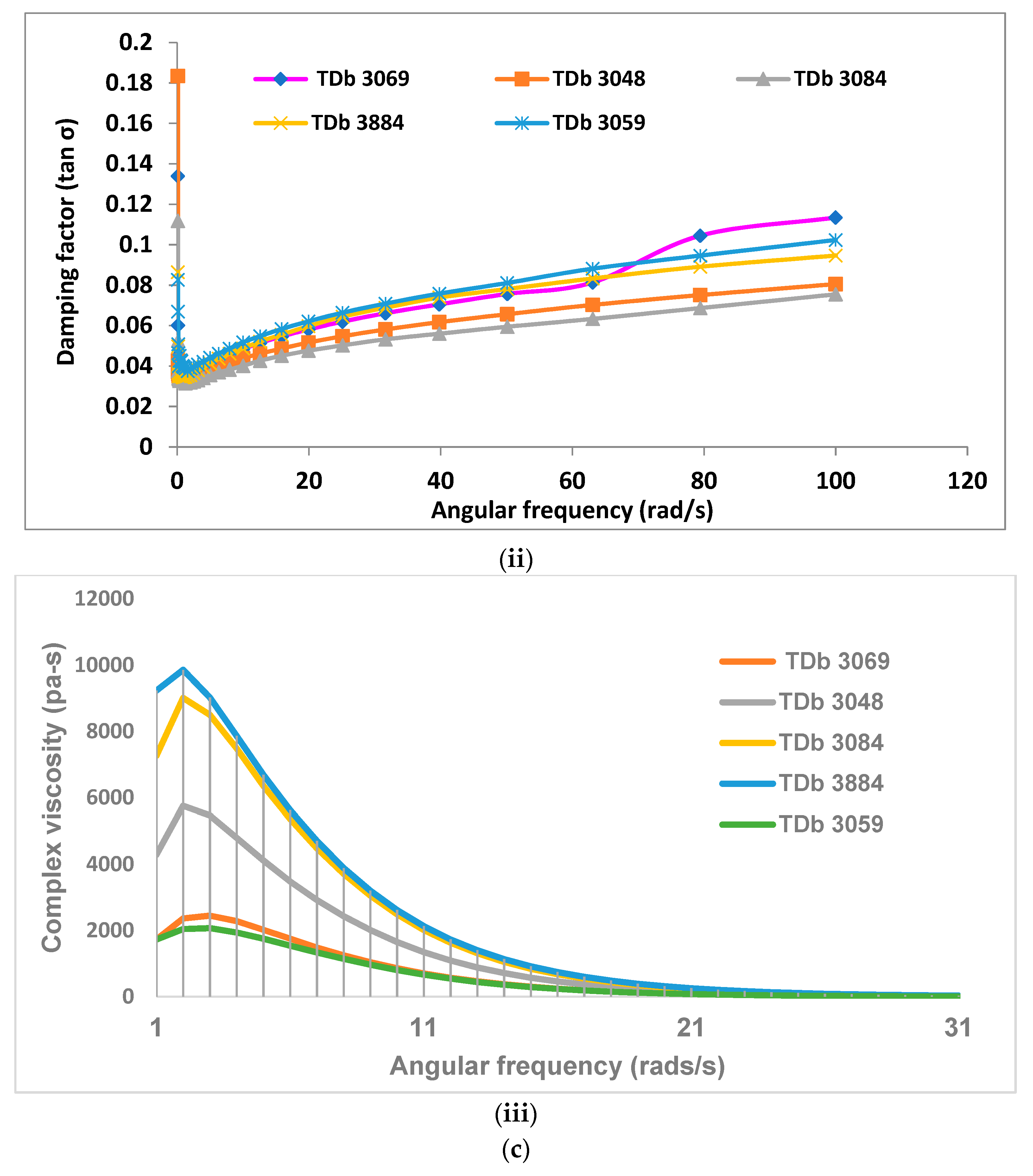
| * Species/Varieties | ** Amylose | Moisture Content | % Crude Protein | % Crude Fat | % Total Ash |
|---|---|---|---|---|---|
| D. dumetorum | 17.08 ± 0.24 | 9.14 ± 0.35 b | 0.15 ± 0.00 a | 0.50 ± 0.00 a | 0.19 ± 0.01 b |
| D. alata | |||||
| TDa 92-2 | 22.53 ± 0.01 b | 14.06 ± 0.01 b | 0.07 ± 0.00 b | 0.00 ± 0.00 c | 0.17 ± 0.00 d |
| TDa 01/00012 | 26.02 ± 1.40 a | 13.37 ± 0.03 d | 0.07 ± 0.00 b | 0.30 ± 0.02 a | 0.30 ± 0.01 a |
| TDa 297 | 23.60 ± 0.28 ab | 14.17 ± 0.03 a | 0.08 ± 0.00 a | 0.00 ± 0.00 c | 0.23 ± 0.00 c |
| TDa 291 | 24.75 ± 0.40 ab | 12.34 ± 0.04 e | 0.07 ± 0.00 b | 0.00 ± 0.00 c | 0.24 ± 0.00 b |
| TDa 93-36 | 25.31 ± 1.58 a | 13.58 ± 0.03 c | 0.07 ± 0.01 b | 0.15 ± 0.02 b | 0.17 ± 0.00 d |
| Mean | 24.44 ± 1.49 a | 13.50 ± 0.73 a | 0.07 ± 0.00 b | 0.09 ± 0.13 b | 0.22 ± 0.05 ab |
| D. bulbifera | |||||
| TDb 3069 | 12.02 ± 0.01 d | 0.07 ± 0.00 c | 0.00 ± 0.00 c | 0.25 ± 0.00 d | 12.02 ± 0.01 d |
| TDb 3084 | 12.42 ± 0.02 c | 0.08 ± 0.00 b | 0.00 ± 0.00 c | 0.31 ± 0.00 a | 12.42 ± 0.02 c |
| TDb 3048 | 13.72 ± 0.01 a | 0.09 ± 0.01 a | 0.07 ± 0.00 b | 0.26 ± 0.00 c | 13.72 ± 0.01 a |
| TDb 3884 | 13.63 ± 0.03 b | 0.06 ± 0.00 d | 0.55 ± 0.01 a | 0.25 ± 0.00 d | 13.63 ± 0.03 b |
| TDb 3059 | 11.98 ± 0.01 e | 0.06 ± 0.00 d | 0.00 ± 0.00 c | 0.30 ± 0.00 b | 11.98 ± 0.01 e |
| Mean | 12.75 ± 0.86 a | 0.07 ± 0.01 b | 0.12 ± 0.24 b | 0.27 ± 0.03 a | 12.75 ± 0.86 a |
| D. rotundata | |||||
| TDr 99-15 | 10.87 ± 0.03 e | 0.08 ± 0.00 b | 0.03 ± 0.01 a | 0.33 ± 0.00 a | 10.87 ± 0.03 e |
| TDr 89/02665 | 16.58 ± 0.02 a | 0.07 ± 0.00 c | 0.02 ± 0.00 b | 0.32 ± 0.00 b | 16.58 ± 0.02 a |
| TDr 93-31 | 13.74 ± 0.02 d | 0.06 ± 0.01 d | 0.00 ± 0.00 c | 0.21 ± 0.01 e | 13.74 ± 0.02 d |
| Baidza | 15.00 ± 0.04 c | 0.06 ± 0.01 d | 0.00 ± 0.00 c | 0.27 ± 0.00 c | 15.00 ± 0.04 c |
| TDr Amula | 16.20 ± 0.03 b | 0.09 ± 0.00 a | 0.00 ± 0.00 c | 0.26 ± 0.00 d | 16.20 ± 0.03 b |
| Mean | 14.48 ± 2.30 a | 0.07 ± 0.01 b | 0.01 ± 0.01 b | 0.28 ± 0.05 a | 14.48 ± 2.30 a |
| Species (Varieties) | * To (°C) | Tp (°C) | Tc (°C) | R (Tc − To) °C | ΔH (J/g) |
|---|---|---|---|---|---|
| D. dumetorum | 76.80 ± 0.19 | 81.400 ± 0.81 | 85.86 ± 0.33 | 9.07 ± 0.13 | 17.41 ± 0.77 |
| D. alata | |||||
| TDa 92-2 | 76.64 ± 0.45 a | 79.84 ± 0.23 a | 83.33 ± 0.35 a | 6.69 ± 0.10 b | 17.67 ± 2.67 a |
| TDa 01/00012 | 75.40 ± 0.12 b | 78.42 ± 0.12 b | 81.56 ± 0.16 b | 6.16 ± 0.04 b | 18.71 ± 0.53 a |
| TDa 297 | 70.92 ± 0.21 d | 79.57 ± 0.37 a | 79.64 ± 0.45 c | 8.72 ± 0.25 a | 15.69 ± 0.35 a |
| TDa 291 | 73.39 ± 0.26 c | 78.00 ± 0.24 b | 82.82 ± 0.50 a | 9.43 ± 0.24 a | 16.36 ± 0.69 a |
| TDa 93-36 | 71.97 ± 0.74 d | 76.75 ± 0.11 c | 81.79 ± 0.25 b | 9.82 ± 0.98 a | 17.31 ± 1.63 a |
| ** Mean | 73.66 ± 2.24 | 78.51 ± 1.19 | 81.83 ± 1.37 | 8.17 ± 1.59 | 17.15 ± |
| D. bulbifera | |||||
| TDb 3069 | 73.89 ± 0.01 a | 79.17 ± 0.00 b | 84.24 ± 0.24 a | 10.35 ± 0.23 a | 16.23 ± 0.34 a |
| TDb 3084 | 73.90 ± 0.52 a | 79.42 ± 0.35 ab | 83.82 ± 0.53 a | 9.92 ± 0.01 a | 16.87 ± 1.42 a |
| TDb 3048 | 76.66 ± 3.46 a | 79.09 ± 0.12 b | 82.60 ± 0.16 b | 5.94 ± 3.36 a | 17.58 ± 0.19 a |
| TDb 3884 | 77.60 ± 3.18 a | 79.92 ± 0.12 a | 83.77 ± 0.14 a | 6.17 ± 3.32 a | 16.19 ± 0.68 a |
| TDb 3059 | 76.93 ± 3.90 a | 79.50 ± 0.24 ab | 83.64 ± 0.22 a | 6.71 ± 3.68 a | 14.76 ± 2.13 a |
| Mean | 75.80 ± 2.64 | 79.42 ± 0.34 | 83.61 ± 0.61 | 7.82 ± 2.88 | 16.33 ± 1.32 |
| D. rotundata | |||||
| TDr 99-15 | 72.97 ± 0.04 a | 77.00 ± 0.47 a | 82.26 ± 0.10 a | 9.30 ± 0.06 a | 17.47 ± 0.76 a |
| TDr 89/02665 | 70.82 ± 0.02 d | 75.42 ± 0.12 a | 80.07 ± 0.08 c | 9.25 ± 0.06 a | 17.66 ± 0.23 a |
| TDr 93-31 | 71.91 ± 0.11 b | 76.25 ± 0.11 a | 80.99 ± 0.12 b | 9.08 ± 0.23 a | 18.40 ± 0.06 a |
| Baidza | 71.46 ± 0.32 c | 77.42 ± 3.18 a | 78.95 ± 0.49 d | 7.50 ± 0.18 c | 17.68 ± 0.84 a |
| TDr Amula | 71.37 ± 0.01 c | 75.50 ± 0.24 a | 79.54 ± 0.21 cd | 8.18 ± 0.22 b | 17.13 ± 0.57 a |
| Mean | 71.70 ± 0.77 | 76.32 ± 1.36 | 80.36 ± 1.24 | 8.66 ± 0.76 | 17.67 ± 0.61 |
Disclaimer/Publisher’s Note: The statements, opinions and data contained in all publications are solely those of the individual author(s) and contributor(s) and not of MDPI and/or the editor(s). MDPI and/or the editor(s) disclaim responsibility for any injury to people or property resulting from any ideas, methods, instructions or products referred to in the content. |
© 2024 by the authors. Licensee MDPI, Basel, Switzerland. This article is an open access article distributed under the terms and conditions of the Creative Commons Attribution (CC BY) license (https://creativecommons.org/licenses/by/4.0/).
Share and Cite
Otegbayo, B.O.; Tanimola, A.R.; Ricci, J.; Gibert, O. Thermal Properties and Dynamic Rheological Characterization of Dioscorea Starch Gels. Gels 2024, 10, 51. https://doi.org/10.3390/gels10010051
Otegbayo BO, Tanimola AR, Ricci J, Gibert O. Thermal Properties and Dynamic Rheological Characterization of Dioscorea Starch Gels. Gels. 2024; 10(1):51. https://doi.org/10.3390/gels10010051
Chicago/Turabian StyleOtegbayo, Bolanle Omolara, Abiola Rebecca Tanimola, Julien Ricci, and Olivier Gibert. 2024. "Thermal Properties and Dynamic Rheological Characterization of Dioscorea Starch Gels" Gels 10, no. 1: 51. https://doi.org/10.3390/gels10010051
APA StyleOtegbayo, B. O., Tanimola, A. R., Ricci, J., & Gibert, O. (2024). Thermal Properties and Dynamic Rheological Characterization of Dioscorea Starch Gels. Gels, 10(1), 51. https://doi.org/10.3390/gels10010051







